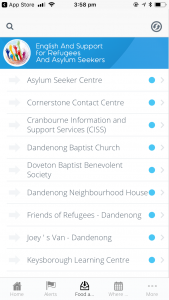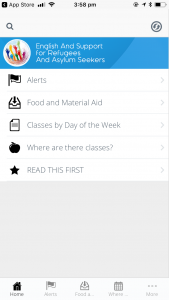
The Dandenong app connecting community
A couple of years ago Andrea Kenny turned up at the Asylum Seeker Resource Centre (ASRC) at Dandenong wanting to help out. She would have been happy to make the coffee she jokes now, but instead she found herself volunteer project managing the set-up of a mobile app designed to provide a centralised list of English classes for people seeking asylum in the Greater Dandenong area.
Dandenong ASRC knew there was a network of organisations in the area offering a variety of English classes at different levels, but precious little cross-sector coordination identifying gaps and overlaps in service delivery. There was no easy way for potential clients to access information about classes either.
Andrea had a background as a Hansard reporter (thirty years in state parliament) but freely admitted IT was not her strong suit. This won’t be a problem, she was assured, as IT assistance would be sourced separately. In other words, if she could coordinate the information to go on it, the ‘appy side’ would take care of itself. Okay, she thought, how hard could it be? However, when a shortage of resources meant IT support was unavailable, it became a little bit harder. As a mother of three children though she was no stranger to multi-tasking or, in the spirit of Dandenong ASRC, adhering to the proverb necessity is the mother of invention.
At the time her youngest child was in Grade 6 at primary school. ‘I thought, what do they do at his school?’ she explains.
‘They were using this daggy little app to say the bus is running late or we’re on our way back from an excursion. Things like that. So I just investigated that app. All I’ve really done is modify that. I just fed the information in and worked it out myself.’
Thus, the app – known as the EAS Network – was launched in 2016 for the princely set-up cost of $1300 and an annual registration fee of $300. It has since been expanded to include food and material aid services, in effect becoming a one-stop shop for refugees and people seeking asylum with pressing needs, whether it be learning English, securing a meal, or acquiring necessary household goods. As at July 2018, near on 700 people have downloaded the EAS app onto their smartphones, and it has enjoyed close to 6000 content views.
There are currently 27 organisations offering classes that are listed on the app, encompassing libraries, schools, neighbourhood houses and organisations in the refugee sector, including the ASRC. While the main focus is English, there are also classes in subjects as diverse as computers, cooking, digital literacy, education and employment pathways, floral art, knitting, renting accommodation, resume making, sewing, and welding. Each listing includes photos of the premises, mention of any childminding facilities, and further contact details. Other useful features of the app include an ability to search classes by day of the week, and a simple translation function.

Originally the app’s acronym of EAS stood for English for Asylum Seekers, but now it stands for English and Support, both reflecting the diversity in classes and the app’s expansion to incorporate food and material aid services (with 16 current listings). These include the food and op shop at the ASRC, alongside a range of organisations offering clothing, food parcels, petrol vouchers, phone and travel cards, chemist assistance, hot showers, household items, laundry services, and meals. ‘If you go to them they’ll tell you they have never been busier. Ever,’ Andrea says.
Andrea’s original volunteer gig was for three months but she decided to stay on to make sure the information on the app was kept up to date. ‘If the information is not accurate, forget it. If people turn up for a class and it’s not on, they’re not going to use the app. So it’s got to be really accurate,’ she says.
With people’s SRSS payments being cut off, the need for an easy and reliable guide to available services is even more critical today. The app allows users to search out what they might need and retain their anonymity at the same time. Andrea explains, ‘People are able to just look on there and say, right, where can I go? They don’t have to ask anybody or anything like that. They can see what a place looks like on the outside, see the opening hours, and what a place offers.’
Anecdotally, Andrea knows the app is reaching a cohort of people that might not otherwise engage with the ASRC. ‘It works with people who are almost invisible,’ she says.
‘For example, a bloke came in [to Dandenong ASRC] last night. He was a Rohingya refugee. He wasn’t registered with the ASRC. But he wanted to know more about English. He needed to improve his English because he wasn’t getting anywhere with work. I showed him how to download the app. He was really quick. And he was out the door like a shot. He wanted the info and he wanted to get out. And that’s happened to me at a few places. When I go around I see people who I recognise that are obviously using the app. They’re just cherry-picking what they want to do. They don’t want to be known. They don’t want their name registered anywhere.’
The “EAS NETWORK” app can be downloaded from the App Store or Play Store to iPhone or Android devices.
Stay up to date with all the latest updates, good news stories, events and information. Join the ASRC community today.
Leave a reply


Connect with us
Need help from the ASRC? Call 03 9326 6066 or visit us: Mon-Tue-Thur-Fri 10am -5pm. Closed on Wednesdays.